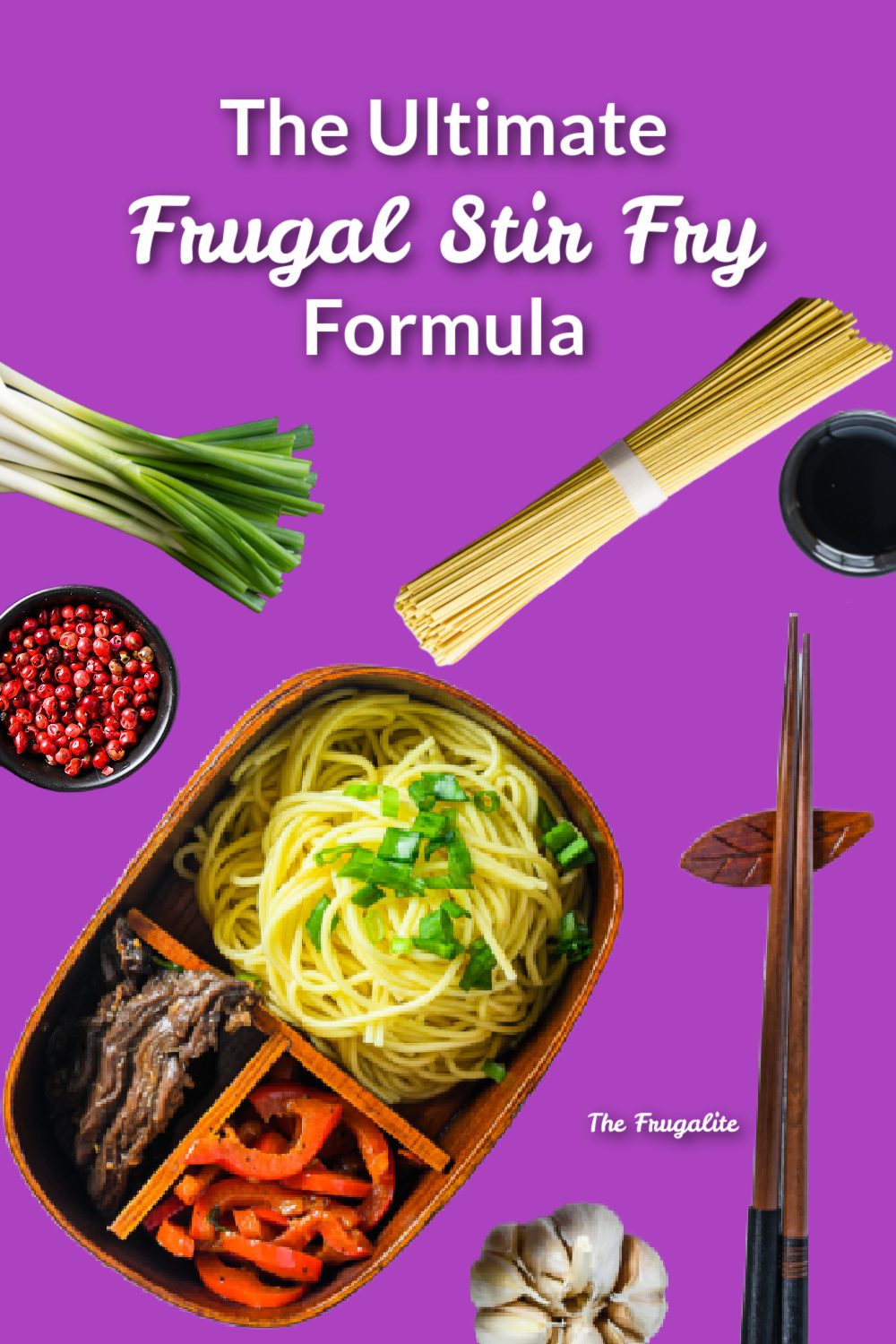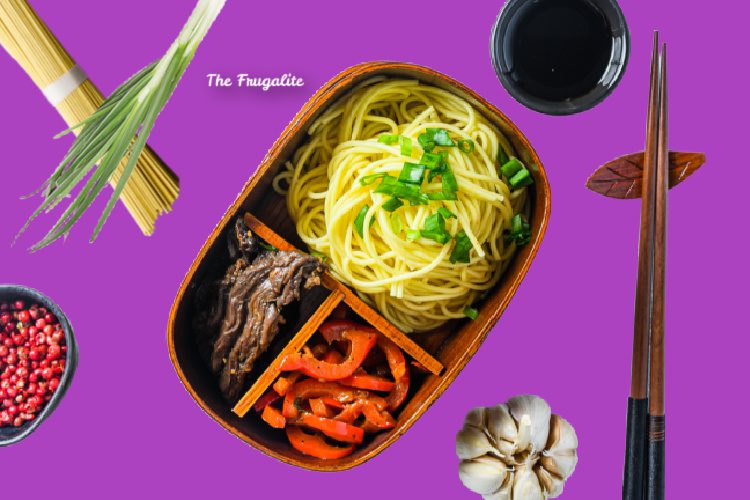(Psst: The FTC wants me to remind you that this website contains affiliate links. That means if you make a purchase from a link you click on, I might receive a small commission. This does not increase the price you’ll pay for that item nor does it decrease the awesomeness of the item. ~ Daisy)
Never underestimate a stirfry for using up odds and ends in your refrigerator or the goodies you got from the last-day-of-sale rack. Much like soups and casseroles, it’s formulaic. Allow me to introduce the Ultimate Frugal Stir-Fry Formula.
I make them 2-3 times per week with a variety of seasonings and sauces, based on the ingredients that I have on hand. the first thing to get out of your head is that stir-fries must be Asian cuisine. While there are many glorious Asian stir-fries, I have several different stirfry concoctions that are anything but Asian. There’s no reason you can’t use the appropriate proteins, carbs, and veggies to make a Tex-Mex stir-fry, an Italian stir-fry, or a Greek stir-fry, just to name a few examples.
The Components of the Ultimate Frugal Stir-Fry Formula
As with all formulas, there are some specific components that are necessary but these can be mixed and matched and made to fit what you have on hand. Here are the basic components of the Ultimate Frugal Stir-fry Formula.
- Protein
- Vegetables
- Fat
- Seasoning
- Carb
- Sauce
The key to a good stirfry is cooking all your foods evenly. So generally speaking, you can’t throw in all the ingredients at once or you will end up with a mix of overcooked and undercooked foods. That is definitely not “ultimate” and you are making an “ultimate” stir fry.
One of my favorite guides to stir-frying food is The Moosewood Cookbook by Molly Katzen. It’s a vegetarian cookbook but you can throw meat into any of the recipes for the carnivores in your family. It goes into exquisite detail about how to chop things up, what to put in your pan first, and how to ensure even cooking of all your ingredients.
Let’s take a closer look at our components.
Protein
Your protein can start out cooked or uncooked, depending on what you have around. If it’s starting out uncooked, it will likely be the first thing that goes into your wok or skillet.
- Beef
- Chicken
- Turkey
- Pork
- Shrimp
- Lunchmeat
- Garbanzos
- Canned beans
- Egg, cooked or raw
- Tofu
Those are just a few ideas – remember, this is your stir-fry. The Ultimate Frugal Stir-fry Formula is only a guideline.
Vegetables
Again, we’re going with what you have on hand. You can use fresh, frozen, or even canned veggies for a stir-fry. The trick to adding canned vegetables is to drain them extremely, extremely well. I let mine sit in a colander while I’m cooking the ingredients that take longer. If you are using canned veggies, throw them in the frying pan when you put in your carb and seasoning. That way they get browned and have a better texture.
Any veggie can go into a stir-fry. My kids LOVE a stir-fry that I make with sweet potato, broccoli, and chicken.
Fat
You can use a wide variety of different fats for a stir-fry, but try to use something that has a high smoke point. You are going to be cranking up the heat toward the end and you want things browned, not burned. What is a smoke point?
A cooking oil‘s smoke point refers to the temperature when the oil starts to smoke—which it will reach before its boiling point. Heating oils past their smoking point has been linked to the formation of carcinogens and can also create an off, burnt flavor. (source)
- avocado oil
- canola oil
- corn oil
- peanut oil
You may not care for some of these oils due to their GMO origins or potential health issues. The choice of which oil to use is entirely up to you. This is just a guideline.
Other fats such as lard, coconut oil, and olive oil can be heated to a fairly high point, but they begin to break down nutritionally.
Seasoning
Onions and garlic are always staples of any stirfry I make, and while they’re technically veggies, I put them in the seasoning category.
You can use spice blends to make all kinds of different stir-fries. Whether you make the blends yourself or purchase them already made, consider the following for your own Ultimate Frugal Stir-fry Formula.
- Chinese 5-spice
- Thai seasoning
- Garam masala (for curries and Indian flavors)
- Taco seasoning
- Montreal steak spice
- Italian spice blend
- Adobo seasoning
- Greek spice blend
Choose a seasoning that goes well with the ingredients with which you are working. Don’t go crazy with the salt because many of the sauce ingredients also contain salt. And note that a tiny pinch of brown sugar can really bring out the flavors.
Carb
To make this more filling and stretch the ingredients a bit further, use an inexpensive carbohydrate such as rice or noodles to add to your stir fry. Cook the carb before adding it in.
It goes without saying that if you are on a special diet that requires you to abide to a lower level of carbohydrates, leave this ingredient out or sub in some bean sprouts for a similar texture to noodles.
Sauce
This is another place you can get super creative. Mix and match the following to come up with your own sauces. Make a sauce that goes along with the type of cuisine you’ve prepared. It would taste pretty weird to add peanut sauce to a Greek stir-fry, right? This is the proverbial icing on the Ultimate Frugal Stir-fry Formula cake.
- Broth
- Soy sauce
- Coconut aminos
- Oyster sauce
- Fish sauce
- Hoison sauce
- Rice wine vinegar
- Apple cider vinegar
- Balsamic vinegar
- Peanut butter
- Cola
- Honey
- Lemon or lime juice
- Fruit juice
The sky really is the limit when making your own sauce. Make it in a separate container and be sure to taste test it before adding it to your skillet.
How to Use the Ultimate Frugal Stir-fry Formula
Gather up all of the ingredients you’ve chosen from the lists above (or from your imagination). Now, let’s get started using the Ultimate Frugal Stir-fry Formula. Notice that there are no quantities listed. This is a fly-by-the-seat-of-your-pants kind of thing that depends on what you have and how many you’re feeding.
- Heat about half of the fat you intend to use in a large skillet or wok on medium heat.
- If you need to cook your meat, add some onion, garlic, and the meat to your skillet and saute it until it’s cooked through.
- Remove the meat from the skillet. I like to put mine in a bowl lined with paper towels to catch the excess fat.
- Add in your vegetables. First cook the ones that take the longest amount of time, like carrots, potatoes, etc. Then add sturdy but faster cooking veggies like broccoli and cauliflower. Finally, stir in the things that only take a couple of minutes such as bean sprouts and shredded cabbage.
- This is where the stirring and the frying comes into play. Add some more fat and crank the heat up to about 8 on your dial. Stirring constantly, add in your seasoning, carbs, already cooked meat, and any drained canned veggies. Do this for 3-5 minutes until they are lightly browned or the texture you desire.
- Next, pour in your sauce. Stir everything well, turn the heat down to 3 or so, pop a lid on it, and let the flavors meld for 3-5 minutes.
Dish it out and if you want, top it with some fresh herbs, chopped peanuts, crunched-up wontons or tortilla chips, or whatever goes with your flavor sensation.
Are you going to give the Ultimate Frugal Stir Fry Formula a shot?
Do you have a favorite kind of stir-fry? What are your must-have stir-fry ingredients? Do you have any tips or questions about the Ultimate Frugal Stir-fry Formula? Let’s talk about stir-fries in the comments.












4 thoughts on “The Ultimate Frugal Stir Fry Formula”
I like the formula format. It sure makes it versatile.
I’ve done this for years and it works. However, as my family quickly learned I cannot repeat the recipe exactly because the ingredients are always different. But different is usually good.
Exactly. Since I’m often using what I have sitting around, it’s different every time.
This brings up a good point, pretty much all recipes with the exception of baked goods (you really need to know what you are doing to substitute in baking) are just suggestions and inspiration. Once you learn to cook recipes almost morph into formulas, basic concepts of a food that can be made with different ingredients but retain the characteristics of that food. You are free to use different ingredients and substitute what you have. This is how and why our grandmothers and great-grandmothers didn’t always have actual recipes, even for family favorites.
If you are just starting out just use a little common sense, think about the flavor of the dish and substitute like for like ie: one vegetable for another or a different type of liquid, and you should be fine. If it turns out wonderful be sure to write it down! Some of our favorite family meals started out this way.
I always write notes in my cookbooks in pencil so I can see them when I look up the recipe but can also change them if I find a better alternative. Also if I want to make something I don’t know how to make offhand I will usually look up a few different recipes and use ideas from all of them.
Some basic “formula” foods:
Chili : tomato product, beans, spices optional: meat or other veggies like corn
Red Sauce for pasta: tomato product and spices optional: meat, garlic, peppers, onions, any other veggies chopped
Marinade and salad dressing: an acid (vinegar, citrus, tomato product, wine), an oil, seasoning
Casserole: starch, liquid and thickener if needed, veggies and/or meat optional toppings (cheese, bread crumbs, ect.)
Soup: flavorful broth optional: starch, veggies, meat, cheese or other dairy, seasonings
Omelette or breakfast casserole: eggs optional: meat, cheese or other dairy, veggies, seasonings, bread or bread crumbs
Pizza: crust of some kind (doesn’t have to be a traditional crust some examples are bagels, pitas, slices of zucchini) , sauce of some kind optional: cheese, meat, veggies, seasonings
Tacos, enchiladas and burritos: a shell of some kind (or skip it for burrito bowls and walking tacos), filling and seasoning (meat, cheese or other dairy, beans, veggies) optional a sauce either in or over
This is just a few basics to get you started. Good luck and happy eating.